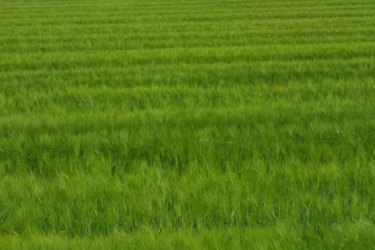
Gardeners must prepare their lawns before seeding. Lime is needed if your soil pH test indicates that your soil is too acidic. Most turf grass types need a pH range between 6.0 to 7.0, according to the University of Rhode Island. Fertilizer may be applied right after liming. Seeding should occur after both soil amendments have been worked into the soil and the planting site is ready for grass seed.
Timing
Video of the Day
The best time to lime, fertilize and seed your lawn is at the beginning of your grass type's growing season. For example, cool season grass seed is typically sown in the fall because this turf type cannot tolerate hot summer weather. Warm season grass types are sown in the spring when ground temperatures have warmed up from the winter. Summer is not an optimal time to sow grass seed. Gardeners must keep the soil moist throughout the seed germination period to prevent young seedlings from drying up.
Video of the Day
Liming
In order to lime, gardeners must find out the existing soil pH. You can send a soil sample to your local cooperative extension office three weeks before your anticipated seeding date; you will receive a report with recommendations on how to adjust the pH to optimal levels. Apply the correct amount of lime to your soil to correct the pH. For example, those with an existing soil pH of 5.6 to 6.0 should apply 50 pounds of limestone per 1,000 square feet, according to Cornell University. Work the limestone into the first 6 inches of topsoil.
Fertilizing
Spread a fertilizer high in phosphorous over the soil. Fertilizers high in phosphorous or starter fertilizers help seedlings develop strong root systems. Using a fertilizer high in nitrogen at the time of seeding may result in burnt seeds. You can use a starter fertilizer with an N-P-K amount of 5-10-5 at a rate of 20 pounds per 1,000 square feet, according to the University of California. Work the starter fertilizer into the top 2 to 4 inches of soil.
Seeding
Seed at the rate appropriate for your turf grass. Excessive seeding results in grass seedlings competing with each other for the soil's nutrients, which slows down your establishment time, according to the University of Minnesota. For instance, Kentucky bluegrass should be seeded at a rate of 2 to 3 pounds per 1,000 square feet. Cover your grass seed with 1/8 of an inch of compost or soil. Keep the planting area moist.